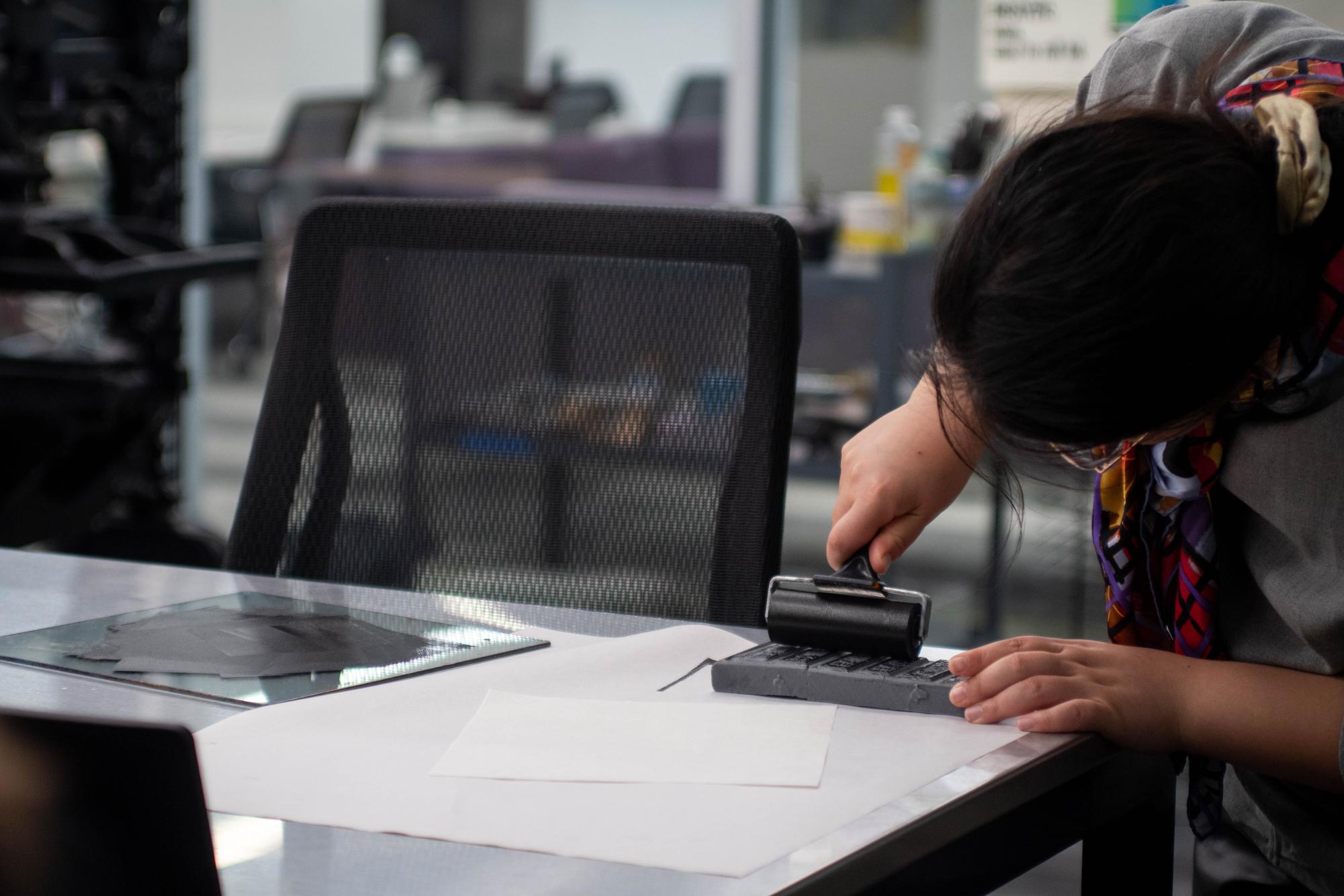Preserving the past: exploring East Asian bookbinding and printing at Hillman Library


A student rolls ink onto a stamp at the East Asian Printing and Bookbinding event in Hillman Library on Tuesday, Sept. 17.
The University of Pittsburgh’s Archives and Special Collections hosted a hands-on bookbinding and printing workshop inspired by various East Asian cultures on Sept. 17. This workshop was open to all students and was located on the third floor of Hillman Library in the Text & conText Lab.
The event was part of the “Creating with Context” series and showcased parts of the University’s collection of 170 East Asian books from the Chinese Ming and Qing Dynasties. The workshop allowed students to explore various bookbinding and printing techniques and materials.
Megan Massanelli, the Archives and Special Collections’ engagement and outreach coordinator, described the structure of the workshop.
“We’re starting here in the reading room to show some examples from our collection, including the paper samples that Runxiao Zhu has selected, and some materials from her personal collection as well,” Massanelli said.
The initial portion of the event gave participants a chance to engage directly with rare East Asian materials, including paper samples and historical examples of bookbinding.
“We like to provide an opportunity for participants to get hands-on with the materials before we go over into the lab and actually make things that are newer,” Massanelli said.
After exploring the exhibit, attendees moved to the Text & conText Lab, where they had the chance to create their own books and prints. Under the guidance of the workshop organizers, participants created their own Japanese stab-bound books and used 3D-printed replicas of original woodblocks to produce their own prints.
According to Massanelli, East Asian cultures have made significant contributions to bookmaking, many of which predate key Western innovations.
“There is such diversity in bookmaking history that it is not just Western,” Massanelli said. “And in fact, it really originates, if you’re talking about movable print, before the 11th century.”
According to Runxiao Zhu, the head of the East Asian library at Hillman and curator for this exhibit, the motivation behind organizing the workshop stems from a desire to highlight the diversity of bookmaking history beyond Western traditions.
“The idea to have this workshop is mostly because I find there’s a lack of non-Western representation in the collection,” Zhu said. “My goal is to expand this part for the Archive and Special Collections.”
For the workshop, Zhu brought her own personal collection of East Asian books and materials in addition to the collection available at the University of Pittsburgh. Zhu emphasized the importance of allowing participants to physically interact with the materials to truly understand East Asian book culture.
“I feel like the books need to be touched. Then you know what you have in the books”, Zhu said. “That’s the most important part of book study and book culture, the use of the materials, not just preserving them for the sake of it.
Zhu further discussed the history of bookmaking and the evolution of the materials used in traditional bookmaking. She said that before paper, early writing was carved into oracle bones before transitioning to bamboo and silk, but these materials were all either too heavy or too costly.
“When the paper was developed, the book format became paper book format, which is much smaller and much lighter in terms of the dimension,” Zhu said.
She also elaborated on the traditional binding methods distinct to East Asia, particularly stitch binding, which is used across China, Japan and Korea.
“We basically put the hole on one side and then use the thread, sometimes silk thread, sometimes cotton thread, to bind the books,” Zhu said.
Anaïs Grateau, the preservation coordinator for Archives and Special Collections, explained that these workshops are designed to cater to a wide range of interests and experience levels.
“If you become absolutely fascinated by East Asian binding from the 14th century, you could spend your whole life mastering this technique,” Grateau said. “However, for those seeking a more casual experience, the workshops offer a welcoming introduction. You can come hang out with a friend, and in about 15 minutes, learn something new.”
Grateau explained the goal is to empower students to return to the lab and explore further.
“Students don’t have to make an appointment or come as part of a class. They can come basically anytime we’re open,” Grateau said. “Maybe someone tonight will make this simple binding and think, ‘Oh, this is kind of cool. I want to explore on my own after.’”
This focus on accessibility and hands-on learning is in line with Massanelli’s goal for the program’s future. She said students can look forward to upcoming workshops and encouraged students to get involved with other events in the “Creating with Context” series.
“We have a ‘Creating with Context’ workshop every semester. Our spring workshop, which the date is TBA, is going to be on paper doll making,” Massanelli said.
Recent Posts
Marquan Pope: The ultimate shark
One of the most remarkable things about sharks is that an injury doesn’t deter them.…
Who Asked? // Do we really get a summer vacation?
This installment of Who Asked? by staff writer Brynn Murawski mourns the seemingly impossible perfect…
Notes From an Average Girl // Notes from my junior year
In this edition of Notes From an Average Girl, senior staff writer Madeline Milchman reflects…
Meaning at the Movies // The Power of the Movie Theater
In this edition of “Meaning at the Movies,” staff writer Lauren Deaton discusses her love…
EMBRACE sponsors Black Maternal Health Wellness week
Because Black women’s maternal health is not institutionally prioritized, Pitt’s EMBRACE sponsored a Black Maternal…
Local ‘Standing Wave’ coffee truck energizes the Pitt food scene
The small business coffee truck “Standing Wave” has become a beloved new coffee spot on…

